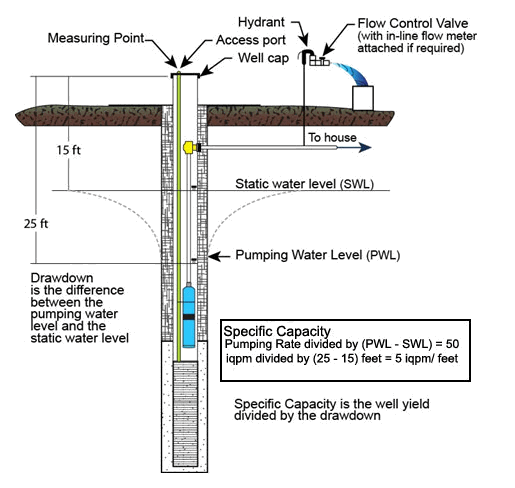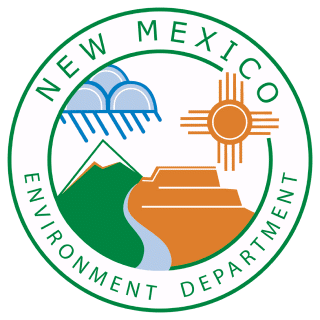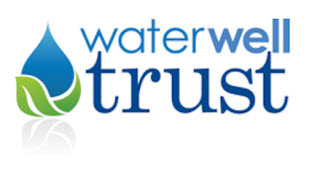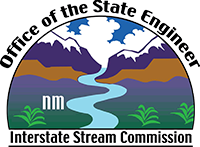Drought in New Mexico
- OSE Home
- Drought in New Mexico
Drought and Your Water Well
Well Supply Issues
A well is said to have gone dry when water levels drop below a pump intake and the well is no longer able to produce water. Many New Mexicans rely on private wells for domestic water. Supply problems in wells may occur due to declining water levels due to the use of other wells, a failing pump, aging, buildup of mineral deposits, silt, bacteria and drought.
You may want to start by examining your well record which describes the well construction and which may be obtained from the New Mexico Office of the State Engineer: Water Rights Reporting System. The well record should show the total depth of the well and the static water level as well as the depth and thickness of the water bearing geologic formations. The distance between the well depth and the static water level gives you the depth of your water column. Seek professional help to determine the depth the pump was set upon completion and the total depth of the well to determine if you are able to lower your pump.
The water level in the aquifer that supplies a well does not always remain the same. The water levels in a shallow well may fluctuate more than levels in a deeper well. Allow for frequent water level measurements to be taken on your well (by an experienced person) and try to observe if pumping by surrounding wells may be causing interference and whether neighboring wells are having similar water supply problems. After studying your water levels through time, you may discover the need to deepen your well, replace or lower the pump, address maintenance related issues or replace your well altogether.
The first defense to your water supply is a properly constructed well. Poor well construction may contribute to poor well production.
Common well supply issues
(Some may require a professional to help you determine the cause)
- Lots of air in the water. Sputtering out of the tap indicates air pockets in the well
- Running out of water after heavy usage (like watering the lawn)
- Pump doesn’t produce as much water as it used to
- Pump runs for a long time before shutting off
- Water pressure is very low
- Tank taking a long time to build up pressure
- Water quality changes or changes in water color
- Neighbors having problems with their wells
Examine pump and well construction issues
(Should be performed by a professional)
Some water wells have been drilled to deep depths, but the pump may be installed at shallower depths. This does not allow the pump access to all of the available groundwater and as groundwater levels decline due to the drought, wells with shallow pumps may experience reduced yields. To keep wells functioning properly, you may consider lowering your pump now and conducting any other well or pump maintenance. Well owners with a flowing artesian well may want to consider installing a pump to ensure access to groundwater in the event the artesian pressure diminishes.
Active drinking water supply wells that are poorly constructed can result in groundwater contamination. Construction problems, such as faulty casings, inadequate covers or lack of concrete pads, allow outside water and any accompanying contaminants to flow into the well. Sources of such contamination can be surface runoff or wastes from farm animals or septic systems. Contaminated fill packed around a well can also degrade well water quality. Well construction problems are more likely to occur in older wells that were in place prior to the establishment of well construction standards.
For help troubleshooting, repairing your well system, drilling a new well, or any of the issues discussed above, the OSE encourages well owners to seek and employ licensed, bonded and insured well drilling contractors. A list of licensed water well drillers may be found on the OSE website: http://nmwrrs.ose.state.nm.us/nmwrrs/drillerLicense.html.
Monitor water levels and water use
 During drought or other dry periods when your well is used a lot, it is helpful to measure the static water level (when the well is not in use) and the depth of your well. OSE encourages well owners to seek and employ experienced individuals in water level measurements and the use of the right equipment to avoid unintended damage(s) to their well(s). The groundwater level in your well is an indication of how much groundwater is available for your use. It is common for groundwater levels to change seasonally, where the groundwater level often increases during the winter and spring as the aquifer recharges from rain and snowmelt. Groundwater levels typically decline through the summer and fall in response to natural recharge/discharge of the aquifer (to streams and springs) and in response to groundwater use from the pumping of wells.
During drought or other dry periods when your well is used a lot, it is helpful to measure the static water level (when the well is not in use) and the depth of your well. OSE encourages well owners to seek and employ experienced individuals in water level measurements and the use of the right equipment to avoid unintended damage(s) to their well(s). The groundwater level in your well is an indication of how much groundwater is available for your use. It is common for groundwater levels to change seasonally, where the groundwater level often increases during the winter and spring as the aquifer recharges from rain and snowmelt. Groundwater levels typically decline through the summer and fall in response to natural recharge/discharge of the aquifer (to streams and springs) and in response to groundwater use from the pumping of wells.
During drought conditions those water levels may drop to levels below what might be considered normal. It is important to know where the groundwater level is relative to your well pump’s intake. If the groundwater level declines to below the pump intake in your well, damage to your pump can occur. A water meter can also be installed and used to measure how much water is being pumped. This information is valuable to understand and manage water use.
Things to Consider
Maintain your well records
Keep a water well file of all maintenance or repair records. This water well file should include copies of:
- The well construction contract and receipt
- Pump installation or maintenance receipts
- Well maintenance receipts or information
- Copy of the Well Log (Water Supply Well Report)
- Results of any water quality tests
- Water level measurements
Drilling Your Well
Financial assistance
-
 Tribes, Colonias, and Privately owned water systems that serve colonias communities
Tribes, Colonias, and Privately owned water systems that serve colonias communities
https://www.rd.usda.gov/programs-services/water-environmental-programs/water-waste-disposal-grants-alleviate-health-risks-tribal-lands-and-colonias/nm - Public Water Suppliers
https://www.epa.gov/sourcewaterprotection/fits
Water Conservation
The OSE Water Use and Conservation Bureau provides the following resources to individuals and communities on how to reduce their water use during these difficult time:
The New Mexico Interactive Plant List provides an expert-recommended list of low-water use, native or adaptive plants.The Fix-a-Leak Program is a website with information on how to find, fix and prevent indoor water leaks.
The New Mexico Gray Water Guide brochure offers information to help individuals decide if gray water is an option.
Consider rain sensors, drip irrigation, native plants, or dormant lawns
Reduce outdoor water use during periods of rainfall. Rain sensors on compatible watering systems will do this automatically. Use efficient outdoor irrigation devices, such as drip irrigation systems.
Consider rainwater as a source
The New Mexico Office of the State Engineer supports the wise and efficient use of the state's water resources; and, therefore, encourages the harvesting, collection and use of rainwater from residential and commercial roof surfaces for on-site landscape irrigation and other on-site domestic uses.
The collection of water harvested in this manner should not reduce the amount of runoff that would have occurred from the site in its natural, pre-development state. Harvested rainwater may not be appropriated for any other uses.
Additional Resources & References
Additional Resources
 |
 |
 |
 |
